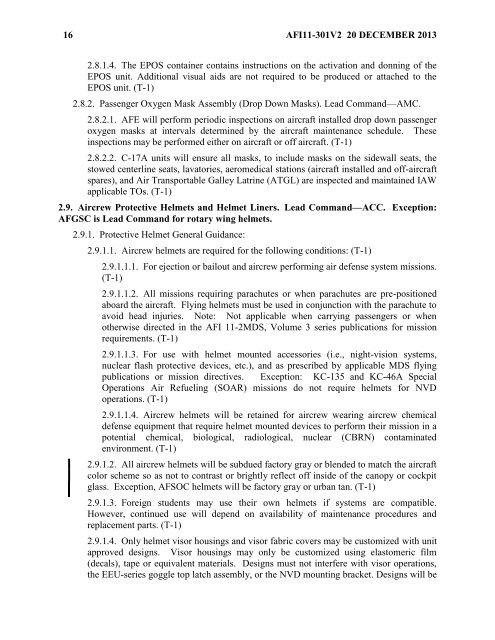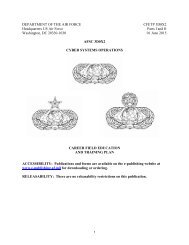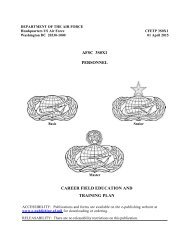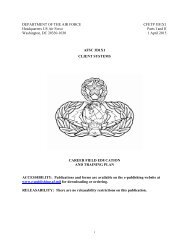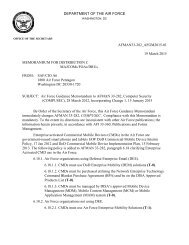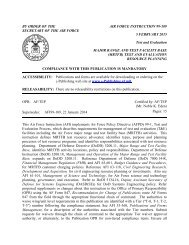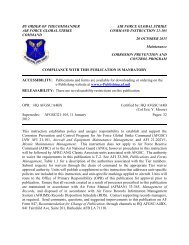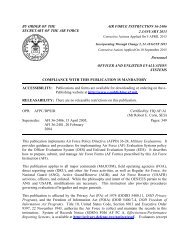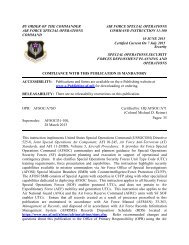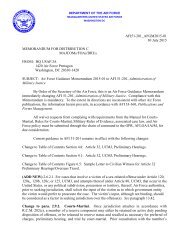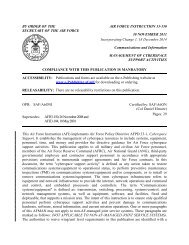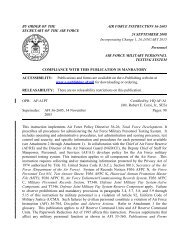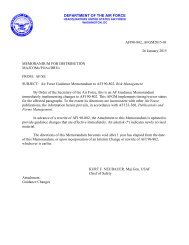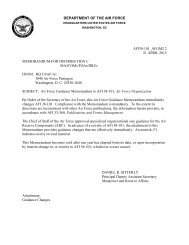COMPLIANCE WITH THIS - Air Force Link
COMPLIANCE WITH THIS - Air Force Link
COMPLIANCE WITH THIS - Air Force Link
You also want an ePaper? Increase the reach of your titles
YUMPU automatically turns print PDFs into web optimized ePapers that Google loves.
16 AFI11-301V2 20 DECEMBER 2013<br />
2.8.1.4. The EPOS container contains instructions on the activation and donning of the<br />
EPOS unit. Additional visual aids are not required to be produced or attached to the<br />
EPOS unit. (T-1)<br />
2.8.2. Passenger Oxygen Mask Assembly (Drop Down Masks). Lead Command—AMC.<br />
2.8.2.1. AFE will perform periodic inspections on aircraft installed drop down passenger<br />
oxygen masks at intervals determined by the aircraft maintenance schedule. These<br />
inspections may be performed either on aircraft or off aircraft. (T-1)<br />
2.8.2.2. C-17A units will ensure all masks, to include masks on the sidewall seats, the<br />
stowed centerline seats, lavatories, aeromedical stations (aircraft installed and off-aircraft<br />
spares), and <strong>Air</strong> Transportable Galley Latrine (ATGL) are inspected and maintained IAW<br />
applicable TOs. (T-1)<br />
2.9. <strong>Air</strong>crew Protective Helmets and Helmet Liners. Lead Command—ACC. Exception:<br />
AFGSC is Lead Command for rotary wing helmets.<br />
2.9.1. Protective Helmet General Guidance:<br />
2.9.1.1. <strong>Air</strong>crew helmets are required for the following conditions: (T-1)<br />
2.9.1.1.1. For ejection or bailout and aircrew performing air defense system missions.<br />
(T-1)<br />
2.9.1.1.2. All missions requiring parachutes or when parachutes are pre-positioned<br />
aboard the aircraft. Flying helmets must be used in conjunction with the parachute to<br />
avoid head injuries. Note: Not applicable when carrying passengers or when<br />
otherwise directed in the AFI 11-2MDS, Volume 3 series publications for mission<br />
requirements. (T-1)<br />
2.9.1.1.3. For use with helmet mounted accessories (i.e., night-vision systems,<br />
nuclear flash protective devices, etc.), and as prescribed by applicable MDS flying<br />
publications or mission directives. Exception: KC-135 and KC-46A Special<br />
Operations <strong>Air</strong> Refueling (SOAR) missions do not require helmets for NVD<br />
operations. (T-1)<br />
2.9.1.1.4. <strong>Air</strong>crew helmets will be retained for aircrew wearing aircrew chemical<br />
defense equipment that require helmet mounted devices to perform their mission in a<br />
potential chemical, biological, radiological, nuclear (CBRN) contaminated<br />
environment. (T-1)<br />
2.9.1.2. All aircrew helmets will be subdued factory gray or blended to match the aircraft<br />
color scheme so as not to contrast or brightly reflect off inside of the canopy or cockpit<br />
glass. Exception, AFSOC helmets will be factory gray or urban tan. (T-1)<br />
2.9.1.3. Foreign students may use their own helmets if systems are compatible.<br />
However, continued use will depend on availability of maintenance procedures and<br />
replacement parts. (T-1)<br />
2.9.1.4. Only helmet visor housings and visor fabric covers may be customized with unit<br />
approved designs. Visor housings may only be customized using elastomeric film<br />
(decals), tape or equivalent materials. Designs must not interfere with visor operations,<br />
the EEU-series goggle top latch assembly, or the NVD mounting bracket. Designs will be


